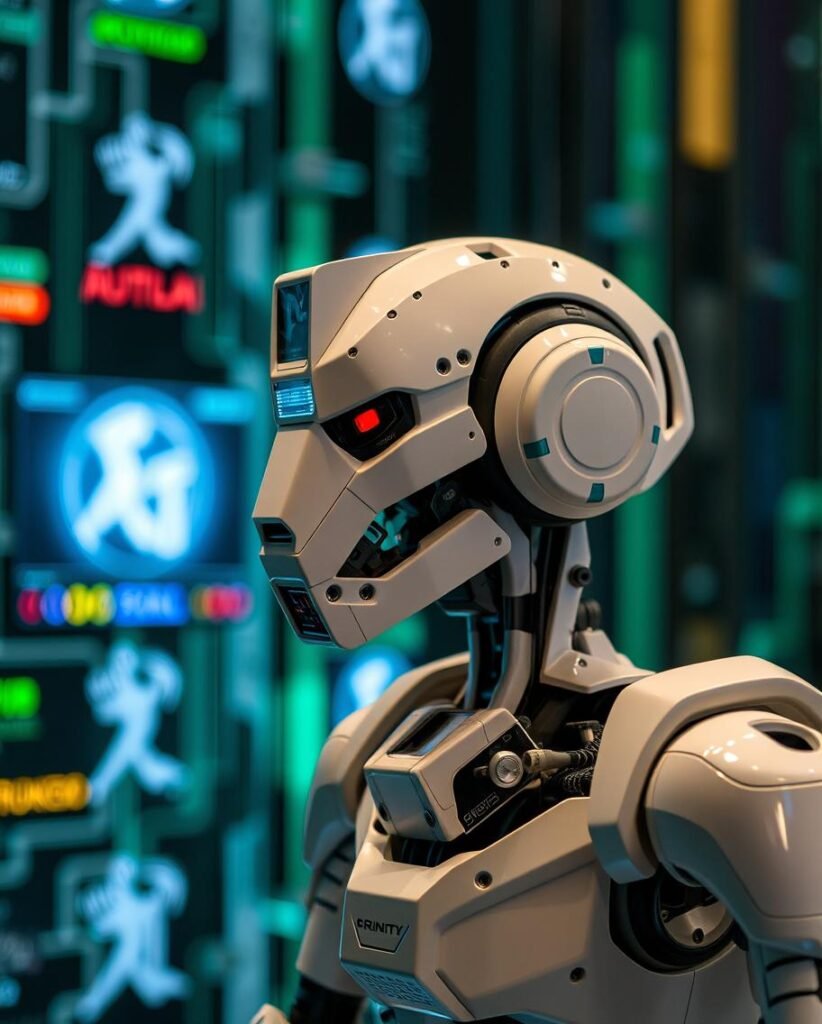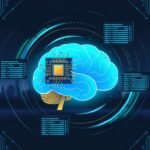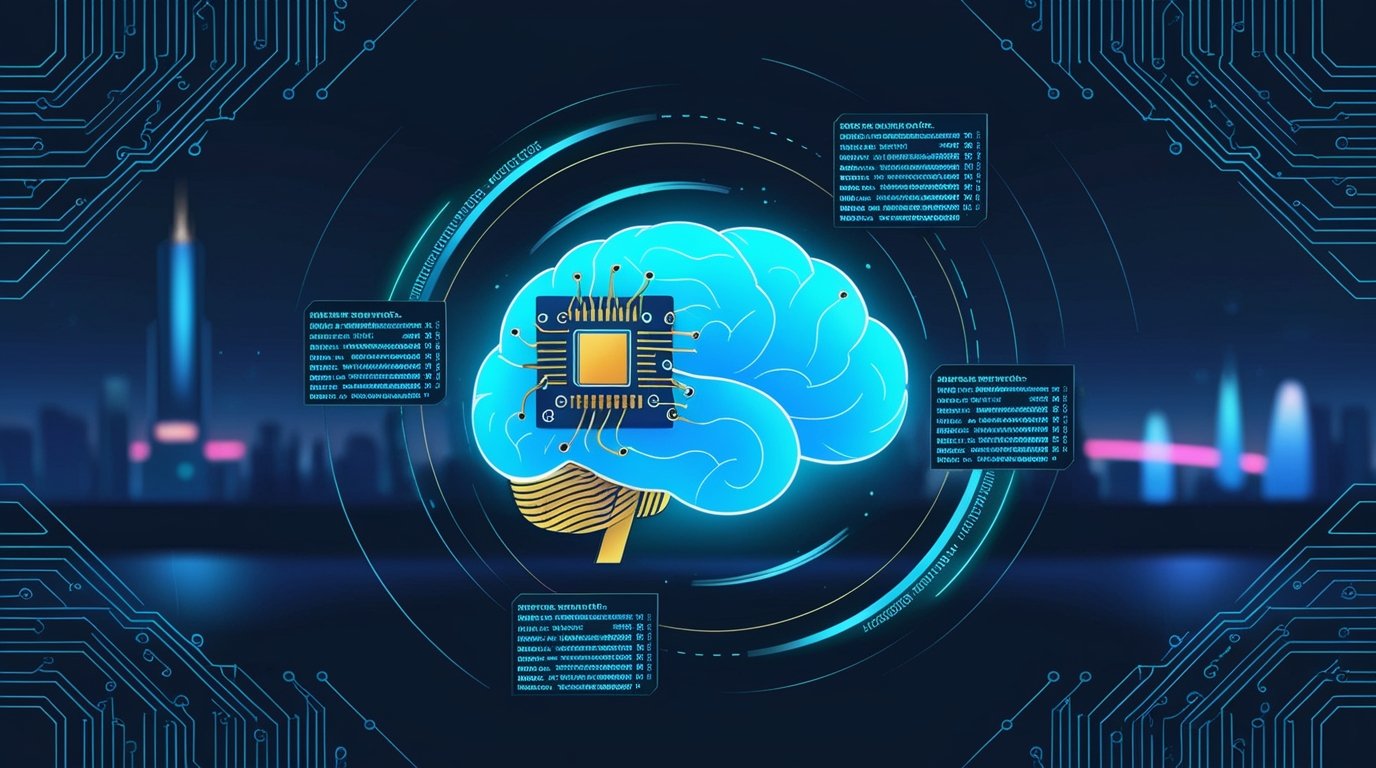Artificial Intelligence (AI) | Google AI Essentials

Join me as we uncover the ways AI can enhance your career and life. There’s a big shift happening in the modern workplace and AI is at the forefront of this exciting transformation. Just as the internet forever changed the way we approach everyday tasks, AI has the potential to transform the way we work and live.
AI stands for artificial intelligence. It’s a practical solution for making routine tasks less time-consuming. Learning to use AI effectively in your job can help you to accomplish your goals and set you up for success in the evolving work landscape. For example, consider a typical day at your work. If it’s anything like mine, you have a lot of tasks to complete.

Some days your to-do list might seem never-ending, but what if AI could help? For instance, instead of spending hours reviewing spreadsheets, AI can help you analyze the information in seconds. It can also draft a detailed sales report, highlighting key insights to share with your team. AI can schedule meetings for you, create engaging presentations, enhance your brainstorming sessions, and take on a variety of other tasks that will shorten your to-do list
Introduction to Artificial Intelligence (AI) | Coursera.
Whether you’re curious to learn the basics of AI, interested in making routine tasks easier, or focused on enhancing your skillset, we’ve designed Google AI Essentials to help. Hi, my name is Maya and I’m the Vice President of Strategy and Operations at Google Research. In my role, I lead a team that helps Google achieve its mission by accelerating research and fostering an exceptional research environment.
I’m thrilled to be your guide on this journey to explore this technology that’s reshaping the business world, AI. Throughout the course, you’ll have the opportunity to learn from a diverse group of AI experts at Google whose roles span from program management to directors of AI products and services.
They’ll each share their insights into AI and how it can elevate your work and advance your career. Google AI Essentials is designed to fit your schedule. You can complete it at your own pace all online and no previous AI experience is necessary. This course will include videos from Google employees who work in AI, readings to help deepen your understanding of concepts, and interactive activities that give you practical experience working with AI.
Exploring Artificial Intelligence: A Guide by Google AI Essentials
At the end of the course, you’ll have the opportunity to earn a skill badge that can be displayed on your resume, social media profiles, and email signature. If you’re new to AI, you may have many unanswered questions. You might wonder, “How do I engage with AI tools to boost my productivity? How do I apply AI responsibly in my job?” Or, “How should I prepare for the future of AI in the workplace?” In Google AI Essentials, we’ll address each of those questions and more.
Getting Started with AI: Insights from Google AI Essentials
I hope you’re excited to join me as we uncover the ways AI can enhance your career and life. Let’s get started. Across every industry, AI is introducing new approaches to work. Companies and organizations of every type are developing innovative solutions to a variety of workplace tasks and challenges, all with the help of AI.
Let’s explore some examples of how AI is reshaping the way people work all across the globe. Consider UKG, a provider of HR and workforce management solutions. By integrating AI into its product suite, UKG is improving how its employees analyze information and insights. This can make it easier and faster for employees to receive answers to their work-related questions.
UKG’s AI integration also enables managers to gain advanced analytics from user interactions, helping them make more informed business decisions. Now, let’s consider one of the oldest industries in the world, farming. AI is also being used to address many challenges in this industry. For example, a common challenge that rural farmers face each year is economic uncertainty due to a variety of factors.
One is frequent changes with crop and livestock yields. Other factors include unpredictable weather conditions and limited access to advanced farming techniques. Uncertainties like these can make it difficult for farmers to make effective business decisions. Jiva is an agricultural company focused on helping rural farmers solve these types of challenges.
Fundamentals of Artificial Intelligence: Google AI Essentials Overview
As part of their mission, Jiva provides farming communities with AI solutions that can assist them in achieving sustainable and reliable farming practices. Jiva uses AI tools that can diagnose crop diseases and suggest remedies. Farmers can also receive relevant AI-powered advice that helps them produce better quality crops and increase yields.
With the help of AI, Jiva helps rural farmers stay informed and access more insights that can improve their business. Overall, AI can be a powerful tool for all kinds of business activities, and no matter the industry, AI has the potential to transform how companies and organizations develop innovative forward-thinking solutions.
As you continue your journey into the world of AI, consider this. In what ways can AI positively impact your industry and how can you be part of that change? In today’s fast-paced world, AI is quickly becoming a standard tool in every company’s toolkit. Navigating the emergence of AI in the workplace is similar to driving down a busy street.
Understanding AI: Key Concepts from Google AI Essentials
Just as knowing the rules of the road can make you a better and more effective driver, understanding the basics of AI can help you to reach your destination safely and to avoid potential roadblocks. To begin this AI journey, let’s start by examining what the term artificial intelligence really means. In this context, intelligence refers to the human ability to perform cognitive tasks.
A cognitive task is any mental activity such as thinking, understanding, learning, and remembering. As humans, we have cognitive abilities that allow us to make decisions and solve problems. However, there are also limits to how much information we can process at a time. AI is capable of extending our cognitive abilities, helping us to make better decisions and solve problems faster.
With that understanding, the term artificial intelligence refers to computer programs that can complete cognitive tasks typically associated with human intelligence. Simply put, AI programs can assist us with tasks by using math to learn from data. As you’ll soon discover, AI has the potential to greatly improve the quality of our work lives and streamline business operations.
However, AI isn’t a magic solution to every business problem. As with any advanced tool, the key is to use AI to its strengths, and doing so requires careful thought and consideration of the technology’s capabilities. Are you curious to discover how AI works? Wanna find out how AI can enhance your work? Then get ready to explore these questions with me in Google AI Essentials.
All the buzz surrounding AI can make it seem like the hottest new tech trend, but the truth is AI has been around for a while. For example, have you ever wondered how streaming platforms recommend videos you might like? This feature is brought to you by AI. For years, streaming platforms have used AI tools to offer services like recommendation systems that enhance the user experience.
An AI tool refers to AI-powered software that can automate or assist users with a variety of tasks. Examples of AI tools are everywhere from GPS systems that suggest quick routes to translation systems that interpret conversations in real time. Companies of all shapes and sizes use AI tools to streamline operations and improve the quality of their products and services.
While these AI tools can seem naturally smart, it’s important to recognize that they’re not self-taught. Instead, they’re powered by what’s known as machine learning. Machine learning, or ML, is a subset of AI focused on developing computer programs that can analyze data to make decisions or predictions.
ML is a specialized layer under the broader category of AI technology. It’s often used by AI tools to make sense of data quickly and efficiently. AI designers build ML programs using a training set, which is a collection of data used to teach AI. Basically, training sets provide ML programs with examples of what to expect and how to respond appropriately.
For example, consider a food distributor that uses an AI tool to sort and pack ripe apples in their factory. For this tool to work, an AI designer must first train an ML program to identify ripe apples. They would do this by providing their ML program with a training set that includes thousands of images of ripe and unripe apples.
As the ML program processes these images, it eventually learns to identify the features of ripe apples. Having learned to do this with ML, the AI tool then identify ripe apples that weren’t in its training set and help factory employees work more efficiently. As I mentioned earlier, many AI tools use ML to learn and improve their performance.
However, for ML programs to perform effectively, the quality and relevance of their training data matter. A fundamental issue to be aware of is the potential for bias within training data. This could unintentionally cause an AI tool to produce inaccurate or unintended outputs. For example, the AI tool that was used to sort ripe apples might have learned from training data that only contain images of specific types of red apples.
This would unintentionally make the AI less accurate at identifying ripe apples of varying sizes, shapes, or colors. The food producer might end up sorting apples incorrectly, causing them to lose money and waste perfectly good apples. When used appropriately, ML plays a key role in advancing AI into the future.
It’s truly an incredible and sophisticated technique with endless applications. Advancements in AI technology are reshaping how we work. Let’s explore one of the key developments at the center of this transformation, generative AI. As the name suggests, generative AI is AI that can generate new content such as text, images, or other media.
A unique quality of generative AI tools is that you can use them with natural language. Natural language refers to the way people talk or write when communicating with each other. Here’s a simplified overview of how a generative AI tool works with natural language. First, you provide input. Input refers to any information or data that’s sent to a computer for processing.
Many generative AI tools accept text and speech as input, and some also accept images or video files. Next, the data is processed by the AI tool. Then an output is generated in the form of text, images, audio, or video. Generative AI and the ability to interact with computers using natural language has introduced a world of possibilities for what people can create with AI.
For example, you might be marketing a new business. You need fresh, engaging content like a promotional poster to advertise a new product, but you don’t have a creative team to bring your ideas to life. No need to stress. With a few instructions, generative AI can help you create a poster. If the generated content doesn’t meet your expectations, you can provide additional instructions until it produces something that meets your needs.
This is just one example of how generative AI can compliment your skills, but there are many other ways it can benefit you and your work. For example, generative AI can boost your productivity by helping you with tasks like drafting replies to emails. It can help you avoid mistakes and it can improve your decision-making process by answering questions and brainstorming ideas with you.
Whether you work in healthcare, education, finance, retail, or any other field, there are a wide variety of generative AI tools that can cater to your needs. One example is a conversational AI tool. A conversational AI tool is a generative AI tool that processes text requests and generates text responses.
You can use it to brainstorm ideas, answer questions, and boost your productivity. Throughout Google AI Essentials, you’ll gain practical experience using a conversational AI tool by Google called Gemini. Gemini can be used to get some creative inspiration when you’re feeling stuck, build on your ideas and provide detailed explanations that help you explore topics easily.
For example, let’s ask Gemini to brainstorm a list of team bonding activities for our summer work retreat. The AI tool responds with a wide range of ideas from a fun beach party to a relaxed pottery class. Gemini also shares some additional tips to consider when planning a successful work retreat. Generative AI has paved the way to exciting new frontiers, but before we can tap into what this technology has to offer, it’s essential to investigate the capabilities and limitations of AI as a whole.
Continue to the next part of this lesson to get started. Just as you don’t need to be a carpenter to use a hammer, you don’t need to be a computer expert to use AI effectively. That said, understanding the basics of what AI can do will help you make the most of the technology. Today’s AI tools can do a lot to enhance your work.
They can generate content like assisting a marketing team by making a promotional video for a new product. They can analyze information quickly, like highlighting the key points of a long email thread. They can answer questions in a detailed and nuanced way, and overall, they can simplify your day-to-day and allow you to focus on other aspects of your work.
While AI can complete a variety of tasks, there are some tasks that require a human touch, such as handling sensitive issues. These limitations can be critical in certain contexts. For example, AI can’t learn independently. It needs people to continually update its training. Shortcomings in an AI tools training data can also potentially reflect or amplify biases, leading to skewed or unfair outcomes.
Another major limitation is that AI output can sometimes contain inaccuracies, otherwise known as hallucinations. Hallucinations are AI outputs that are not true. These inaccuracies can range from minor errors such as a sentence that doesn’t make sense to significant distortions. For instance, consider a sales manager who’s using an AI tool to analyze quarterly sales data.
The AI tool might identify declining sales of a particular product and flag the item as something that should be removed from stores. However, what if there were a seasonal factor affecting sales that hadn’t been accounted for in the AI tool’s analysis? Hallucinations like this one can lead to misguided decisions if the user doesn’t review the AI tool’s output.
Considering AI’s limitations, human oversight over AI-generated output is crucial to ensure that the information is accurate and ethical. Effective management of AI in the workplace requires teamwork from technical to non-technical roles to ensure that AI’s output and decision-making processes are aligned with values that benefit people.
Ultimately, an inclusive approach that maintains human oversight over these tools is the key to shaping a brighter future where AI works for everyone. Ever wondered how to turn your busy workday into an orderly operation? Let’s consider the incredible ways AI can enhance your day-to-day processes. When we use AI at work, embracing a people first strategy is essential.
AI enhances our unique human skills and simplifies many of the tasks that we perform. Essentially, AI augments our own capabilities. In this context, AI augmentation refers to the process of using AI to improve a work product, whether by making it easier to do or higher in quality. For example, think of your own job or a job you might have held in the past.
Like mine, your job probably consists of a variety of tasks and duties. Some of the tasks might be simple, like manually responding to routine questions over email. Other tasks might be more complex, like brainstorming new ideas with coworkers. AI can help you with many of these things by augmenting the work you do, helping you complete the tasks quicker and more efficiently.
Another way AI can help you to do your work is through automation. AI automation refers to the process of using AI to accomplish tasks without any action on the user’s part. For example, maybe a customer support representative receives hundreds of emails every day from customers asking for help. They might spend a lot of time reading each email and typing responses one at a time.
Using an AI tool, they could automatically sort incoming emails by priority. For emails with low priority, they could use AI to draft replies. With some guidance from other customer support agents or training data containing past replies, the AI could learn to quickly generate quality email responses. By automating this task, the representative could then focus on high priority messages, like ones reporting complex issues that require personal attention.
Striking the right balance between augmentation and automation takes time, practice, and thoughtful consideration. Successful businesses can set themselves apart by applying a people first approach to AI in their products, services, and jobs. Think of AI as a collaborative workspace that thrives on diverse perspectives.
Consider a public relations professional who wants to use AI to assist in the creation of press releases. To make sure they get an optimal result, they need to provide human oversight of the AI tool, but it shouldn’t stop there. It’s essential that they also collaborate with other members of their team, such as managers who can coordinate resources for the project, members of the editorial team to ensure that the releases are representative of the brand’s voice, and guidance from the legal department
to ensure appropriate rules and regulations are followed. Everyone has to cooperate to integrate AI successfully and to make sure the tool’s generated output meets expectations. Integrating AI at work must be an inclusive process. It requires diverse perspectives from people across different roles and departments to achieve the best results.
In today’s rapidly-evolving business landscape, it’s critical to learn and adapt as AI is introduced into the workplace. By taking the time to understand AI and how it can provide benefits in your work, you can effectively contribute to the discussion. AI isn’t just about adopting the latest tech.
The goal should be to thoughtfully incorporate AI in a way that puts people first and adds value to your work. In this section, we discovered how AI works, including the fundamentals of AI and machine learning. We investigated the capabilities and limits of AI. We also examined how AI can enhance your work and help you become more efficient.
The AI field is constantly changing. New advancements are made every day, and the technology is continuously improving. I hope this experience serves as an exciting introduction into new AI-powered possibilities. To continue learning, I encourage you to explore how to transform the way you work with AI as a part of Google AI Essentials.











